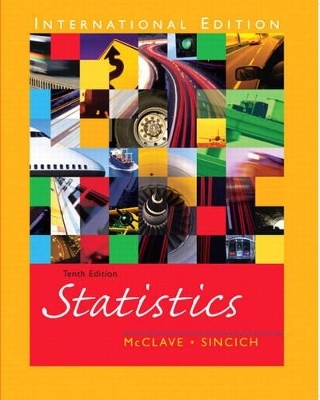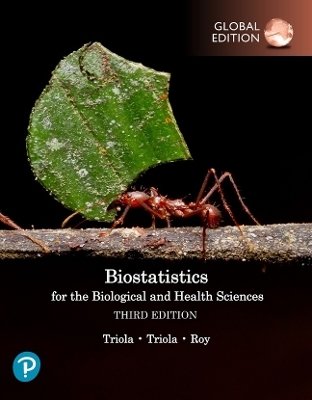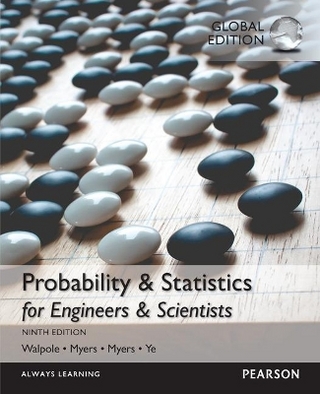
Statistics
Pearson
978-0-13-200302-5 (ISBN)
- Titel erscheint in neuer Auflage
- Artikel merken
For algebra-based Introductory Statistics Courses in Statistics.
The Tenth Edition of this best-selling introductory text emphasizes inference and sound decision-making through its extensive coverage of data collection and analysis. Incorporating more pedagogy then ever before, the text helps develop statistical thinking and teaches students to properly assess the credibility of inferences - from the vantage point of both the consumer and the producer. Statistics assumes a mathematical background of basic algebra.
1 Statistics, Data, and Statistical ThinkingThe Science of Statistics. Types of Statistical Applications.Fundamental Elements of Statistics. Types of Data. Collecting
Data. The Role of Statistics in Critical Thinking. Statistics in Action: USA Weekend Teen Surveys - Are Boys Really from Mars and Girls from Venus? Using Technology: Creating and Listing Data in MINITAB
2 Methods for Describing Sets of DataDescribing Qualitative Data. Graphical Methods for Describing Quantitative Data. Summation Notation. Numerical Measures of Central Tendency. Numerical Measures of Variability. Interpreting the Standard Deviation. Numerical Measures of Relative Standing. Methods for Detecting Outliers (Optional). Graphing Bivariate Relationships (Optional). Distorting the Truth with Descriptive Techniques. Statistics In Action: The "Eye Cue" Test: Does Experience Improve Performance? Using Technology: Describing Data in MINITAB.
3 ProbabilityEvents, Sample Spaces, and Probability. Unions and Intersections. Complementary Events. The Additive Rule and Mutually Exclusive Events. Conditional Probability. The Multiplicative Rule and Independent Events. Random Sampling. Some Counting Rules (Optional). Bayes' Rule (Optional). Statistics In Action: Lotto Buster! Using Technology: Generating a Random Sample in MINITAB.
4 Discrete Random VariablesTwo Types of Random Variables. Probability Distributions for Discrete Random Variables. Expected Values of Discrete Random Variables. The Binomial Random Variable. The Poisson Random Variable (Optional). The Hypergeometric Random Variable (Optional). Statistics in Action: Probability in a Reverse Cocaine Sting. Using Technology: Binomial, Poisson, and Hypergeometric Probabilities in MINITAB.
5 Continuous Random VariablesContinuous Probability Distributions. The Uniform Distribution. The Normal Distribution. Descriptive Methods for Assessing Normality. Approximating a Binomial Distribution with a Normal Distribution(Optional). The Exponential Distribution (Optional). Statistics in Action: Super Weapons Development - Optimizing the Hit Ratio. Using Technology: Normal Probability Plots in MINITAB.
6 Sampling DistributionsWhat is a Sampling Distribution? Properties of Sampling Distributions: Unbiasedness and Minimum Variance (Optional). The Central Limit Theorem. Statistics in Action: The Insomnia Pill. Using Technology: Simulating a Sampling Distribution in MINITAB.
7 Inferences Based on a Single Sample: Estimation with Confidence IntervalsLarge-Sample Confidence Interval for a Population Mean. Small-Sample Confidence Interval for a Population Mean. Large-Sample Confidence Interval for a Population Proportion. Determining the Sample Size.Identifying the Parameter to be Estimated. Statistics in Action: Speed - Improving the Sprint Times of High School Football Players. Using Technology: Confidence Intervals in MINITAB.
8 Inferences Based on a Single Sample: Tests of HypothesisThe Elements of a Test of Hypothesis. Large-Sample Test of Hypothesis About a Population Mean. Observed Significance Levels: p-Values. Small-Sample Test of Hypothesis About a Population Mean. Large-Sample Test of Hypothesis About a Population Proportion. Calculating Type II Error Probabilities: More About _ (Optional). Test of Hypothesis About a Population Variance (Optional). Identifying the Parameter to be Tested. Statistics in Action: Diary of a Kleenex User. Using Technology: Tests of Hypothesis in MINITAB.
9 Inferences Based on a Two Samples: Confidence Intervals and Tests of HypothesesComparing Two Population Means: Independent Sampling. Comparing Two Population Means: Paired Difference Experiments. Comparing Two Population Proportions: Independent Sampling Determining the Sample Size. Comparing Two Population Variances: Independent Sampling (Optional). Identifying the Parameter of Interest. Statistics in Action: Detection of Rigged Milk Prices. Using Technology: Two-Sample Inferences in MINITAB.
10 Analysis of Variance: Comparing More Than Two MeansElements of a Designed Experiment. The Completely Randomized Design. Multiple Comparisons of Means. The Randomized Block Design. Factorial Experiments. Statistics in Action: On the Trail of the Cockroach. Using Technology: Analysis of Variance in MINITAB.
11 Simple Linear RegressionProbabilistic Models. Fitting the Model: The Least Squares Approach. Model Assumptions. Assessing the Utility of the Model: Making Inferences About the Slope _1. The Coefficients of Correlation and Determination. Using the Model for Estimation and Prediction. A Complete Example. Statistics in Action: Can "Dowsers" Really Detect Water? Using Technology: Simple Linear Regression in MINITAB.
12 Multiple Regression and Model BuildingMultiple Regression Models. The First-Order Model: Inferences About the Individual Parameters. Checking the Overall Utility of a Model. Using the Model for Estimation and Prediction. Model Building: Interaction Models. Model Building: Quadratic and other Higher-Order Models. Model Building: Qualitative (Dummy) Variable Models. Model Building: Models with both Quantitative and Qualitative Variables. Model Building: Comparing Nested Models. Model Building: Stepwise Regression. Residual Analysis: Checking the Regression Assumptions. Some Pitfalls: Estimability, Multicollinearity, and Extrapolation. Statistics in Action: Bid-Rigging in the Highway Construction Industry. Using Technology: Multiple Regression in MINITAB.
13 Categorical Data AnalysisCategorical Data and the Multinomial Distribution. Testing Categorical Probabilities: One-Way Table. Testing Categorical Probabilities: Two-Way (Contingency)Table. A Word of Caution About Chi-Square Tests. Statistics in Action: The Level of Agreement Among Movie Reviewers — Thumbs Up or Thumbs Down? Using Technology: Chi-Square Analyses in MINITAB.
14 Nonparametric StatisticsIntroduction: Distribution-Free Tests. Single Population Inferences. Comparing Two Populations: Independent Samples. Comparing Two Populations: Paired Difference Experiment. Comparing Three or More Populations: Completely Randomized Design. Comparing Three or More Populations: Randomized Block Design. Inferences about Rank Correlation. Statistics in Action: Deadly Exposure: Agent Orange and Vietnam Vets. Using Technology: Nonparametric Analyses in MINITAB.
Appendix A: TablesRandom Numbers. Binomial Probabilities. Poisson Probabilities. Normal Curve Areas. Exponentials. Critical Values of t. Critical Values of _2.Percentage Points of the F Distribution, _=.10. Percentage Points of the F Distribution, _=.05. Percentage Points of the F Distribution, _=.025. Percentage Points of the F Distribution, _=.01. Critical Values of TL and TU for the Wilcoxon Rank Sum Test: Independent Samples. Critical Values of T0 in the Wilcoxon Paired Difference Signed Rank Test. Critical Values of Spearman’s Rank Correlation Coefficient.
Appendix B: Calculation Formulas for Analysis of Variance
Short Answers to Selected Odd-Numbered Exercises
Index
| Erscheint lt. Verlag | 17.3.2005 |
|---|---|
| Sprache | englisch |
| Maße | 203 x 254 mm |
| Gewicht | 1666 g |
| Themenwelt | Mathematik / Informatik ► Mathematik ► Statistik |
| ISBN-10 | 0-13-200302-3 / 0132003023 |
| ISBN-13 | 978-0-13-200302-5 / 9780132003025 |
| Zustand | Neuware |
| Haben Sie eine Frage zum Produkt? |
aus dem Bereich

